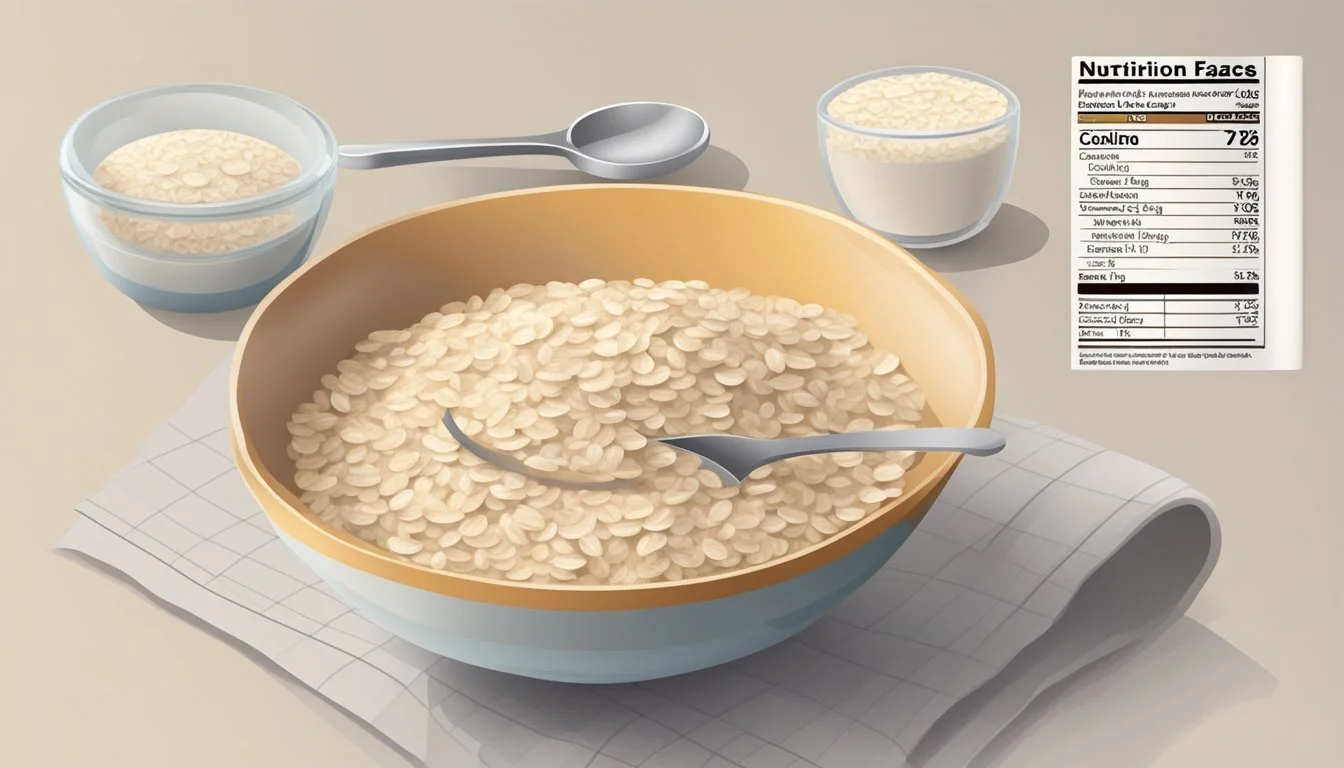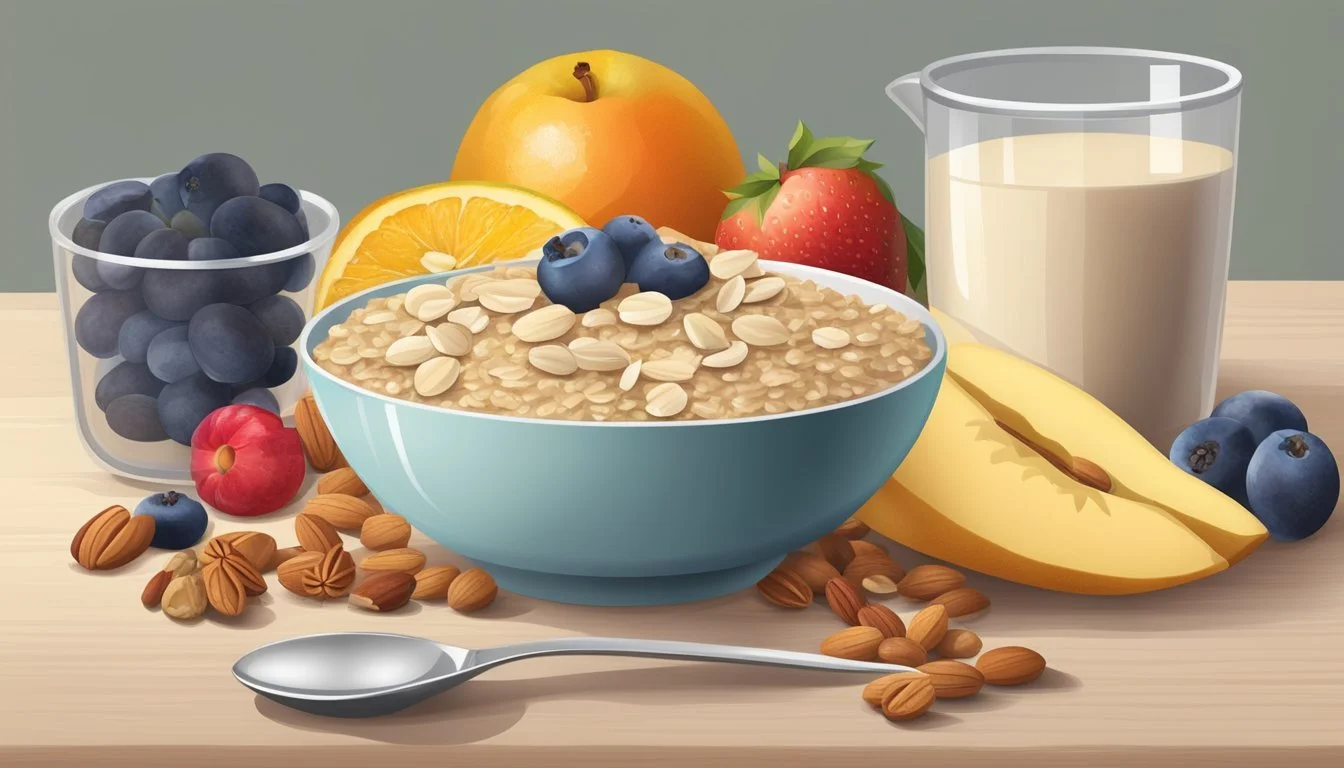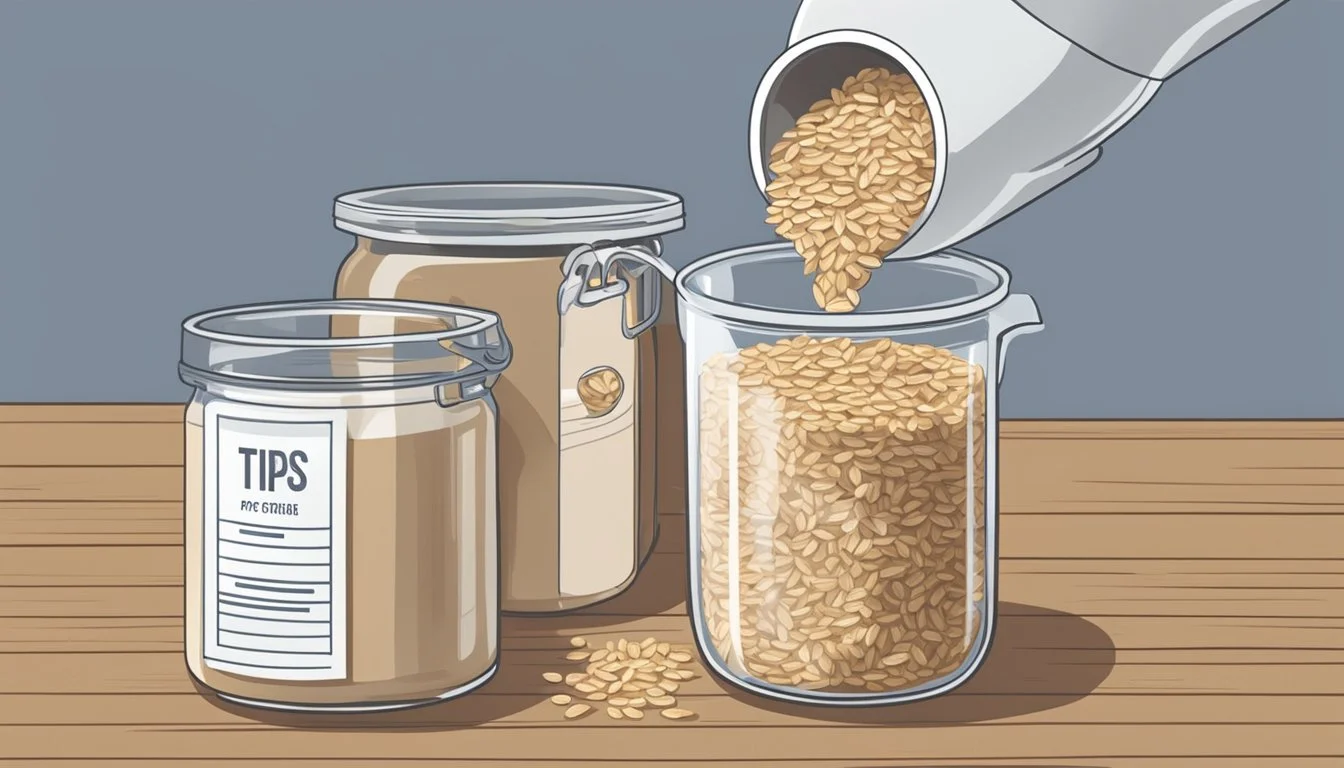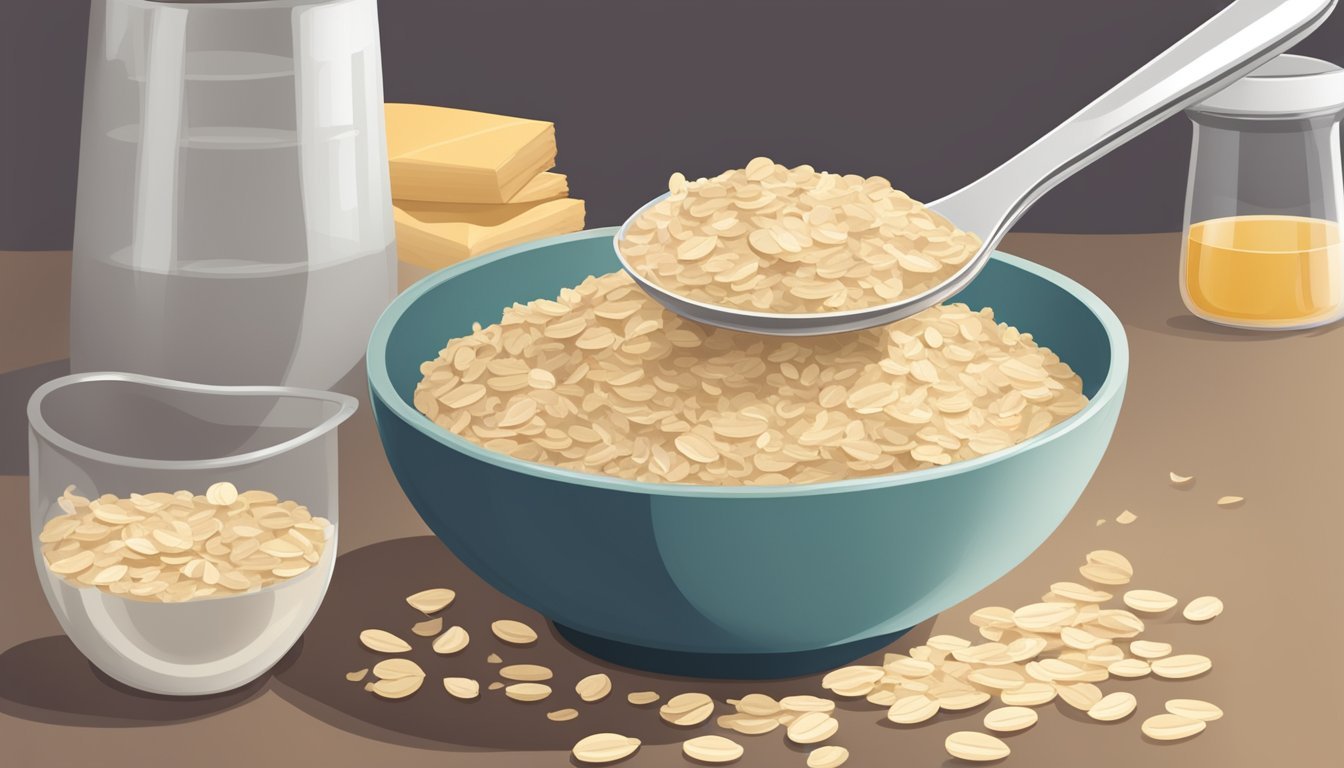How Much Oatmeal Per Day is Too Much?
Understanding Daily Limits
Oatmeal has long been celebrated for its numerous health benefits. It is a staple breakfast food known for its high fiber content, which can aid in digestion, lower cholesterol levels, and help manage blood sugar. A warm bowl of oatmeal is not just comforting; it can be a powerhouse of nutrition, providing a balanced intake of carbohydrates, protein, and healthy fats. The soluble fiber, particularly beta-glucan, is significant in oatmeal, contributing to its positive effects on health markers such as hyperglycemia and weight management.
However, understanding the appropriate serving size is crucial as consuming oatmeal in excessive amounts can have undesirable effects on one's health. The recommendation for grain intake in a 2,000-calorie diet includes up to 6 ounces of grains per day, where oatmeal can contribute to this daily grain requirement. While a typical serving of oatmeal is beneficial, excessive intake can lead to weight gain and nutritional imbalances, especially when high-calorie toppings are added.
Determining the right amount of oatmeal to consume depends on individual dietary needs and caloric intake. It's important to consider the balance of one's overall diet to ensure that oatmeal contributes positively to nutritional goals without leading to overconsumption. Keeping portions in check and being mindful of added sugars and fats can help preserve the healthful qualities of oatmeal as part of a well-rounded diet.
Nutritional Profile of Oatmeal
Oatmeal possesses a significant nutritional value due to its rich content of vitamins, minerals, and other key nutrients. It offers a considerable amount of dietary fiber and protein with a balanced caloric contribution, varying by the type of oat.
Key Nutrients and Benefits
Fiber: Oatmeal is particularly high in beta-glucan, a type of soluble fiber that contributes to maintaining healthy blood cholesterol levels and supports regular bowel movements.
Protein: Essential for muscle repair and growth, oatmeal provides about 5 grams of protein per serving.
Carbohydrates: Comprising mainly complex carbohydrates, it slowly digests, preventing blood sugar spikes.
Vitamins & Minerals: Oats are a good source of important vitamins and minerals such as B-vitamins, iron, magnesium, and selenium which are vital for numerous bodily functions.
Caloric Content and Serving Size
The caloric content of oatmeal varies with serving size:
1 cup of raw oats contains approximately 307 calories.
A typical serving size is half a cup of dry oats, which equates to about 150 calories once cooked.
Types of Oats and Their Differences
Different types of oats undergo varying levels of processing, affecting their nutritional content and cooking time.
Steel-Cut Oats: These are whole oat groats that have been chopped into pieces. They are minimally processed, retaining most of their fiber and nutrients.
Rolled Oats: Also known as old-fashioned oats, these are steamed and flattened. They offer similar nutritional value to steel-cut oats but with a shorter cooking time.
Instant Oats: These are the most processed, often pre-cooked and dried with added salt or sugar. The nutritional value is less compared to steel-cut and rolled oats due to the loss of some fiber and other nutrients during processing.
Overnight Oats: Typically made with rolled oats, they are soaked overnight in a liquid. The soaking process does not significantly alter the nutritional value compared to cooked rolled oats.
Health Benefits of Oatmeal
Oatmeal, a nutritious whole grain, offers several health benefits related to cardiovascular health, digestive wellness, weight management, blood sugar regulation, and immune system support due to its rich fiber content and presence of beta-glucan.
Cardiovascular Health
Oatmeal is beneficial for heart health because it contains soluble fiber, which can help reduce cholesterol levels. High-fiber diets are associated with lower risks of developing heart disease. The fiber in oatmeal binds with cholesterol in the digestive tract, leading to its excretion from the body.
Digestive Wellness
The dietary fiber in oatmeal aids the digestive system. It helps maintain regular bowel movements and supports a healthy digestive tract. Additionally, since oatmeal is fermented by gut bacteria, it enhances digestive health by acting as a prebiotic and promoting the growth of beneficial bacteria.
Weight Management
Oatmeal can assist in weight management and support weight loss goals. The high fiber content contributes to satiety, helping individuals feel fuller for longer and potentially reducing overall calorie intake. This can be a valuable component of a weight loss diet.
Blood Sugar Regulation
Regular consumption of oatmeal may aid in regulating blood sugar levels, which is particularly important for individuals with diabetes. The beta-glucan in oatmeal helps improve insulin sensitivity and may lower the rise in blood sugar after a meal.
Immune System Support
Beta-glucan, a type of soluble fiber found abundantly in oatmeal, also plays a role in supporting the immune system. It can help modulate immune responses and offers protective effects against infection.
Recommended Oatmeal Intake
Optimal oatmeal consumption varies depending on individual dietary needs, but standard guidelines suggest a balanced approach to portion sizes. Here's how adults can manage their oatmeal intake effectively.
Guidelines for Adults
According to dietary recommendations, adults should consume about 6 ounces of grains daily on a 2,000-calorie diet, with half being whole grains. For oatmeal, a serving size is generally considered to be 1/2 cup of raw oats, which equates to about 1 cup when cooked. This portion provides around 150-200 calories, 3.5 grams of fat, and a good balance of carbohydrates and protein, contributing to weight management and satiety. However, requirements may vary based on individual factors such as age, sex, weight, and activity level, so consulting with a dietitian or doctor is advised for personalized advice.
Portion Control Tips
Managing portion sizes is key to enjoying oatmeal's health benefits without overconsumption. Here are some practical tips:
Measuring Cups: Always use measuring cups for raw oats to avoid unintentional overeating.
Nutritional Labels: Check the labels to understand the caloric and nutritional content of different oatmeal types.
Add-ins: Be mindful of the extras. Adding too many high-calorie toppings can quickly increase the portion size.
Listen to Your Body: Pay attention to hunger and fullness cues to determine the right amount for you.
Consistency: Regularly including oatmeal in your diet can provide a sense of fullness and help in weight management.
Individuals looking to optimize their oatmeal intake for health benefits should consider these guidelines and tips, tailoring them to fit their specific dietary goals.
Risks of Excessive Oatmeal Consumption
While oatmeal is praised for its nutritional benefits, including weight management, consuming it in excessive amounts can lead to health complications. Understanding the risks associated with overindulging in oatmeal is crucial for maintaining a balanced diet and achieving health and weight loss goals.
Weight Gain and Caloric Surplus
Though oatmeal can be a component of a weight loss diet due to its high fiber content, excessive consumption can lead to a caloric surplus and potential weight gain. A single cup of cooked oatmeal contains approximately 150 calories. When one exceeds their daily caloric needs with too much oatmeal, the body may store the extra calories as fat.
Calories per cup of cooked oatmeal: Approximately 150
Role of excess calories: Potential weight gain if caloric intake exceeds expenditure
Nutrient Imbalance and Health Concerns
Oatmeal provides important nutrients, including fiber and carbs, but neglecting other food groups for an oatmeal-heavy diet may cause a nutrient imbalance. Health issues, such as muscle mass shedding and malnutrition, can arise if the body is deprived of varied nutrition. Additionally, consuming large quantities of fiber without adequate hydration may result in health conditions like pica, an eating disorder characterized by craving and consuming non-food items.
Fiber amount per cup: 4 grams of dietary fiber
Nutrient imbalance risk: Essential when fiber-rich oatmeal displaces other nutrient sources
Gastrointestinal Issues
Incorporating fiber into one's diet is beneficial for the digestive tract, but too much fiber from overconsumption of oatmeal can create gastrointestinal discomfort. Symptoms may include bloating, gas, and constipation. Moderate intake of oatmeal, coupled with sufficient fluid intake, helps prevent these digestive issues.
Digestive symptoms: Bloating, gas, constipation
Preventive measure: Moderate oatmeal consumption with adequate hydration
Enhancing Oatmeal for Optimal Nutrition
To elevate oatmeal's nutritional profile, one should focus on diverse preparation methods, protein and healthy fat integration, and careful addition of fruits, nuts, and sweeteners.
Innovative Recipes and Preparation Methods
Experimenting with overnight oats or utilizing kitchen appliances like the slow cooker or microwave can transform oatmeal from a simple breakfast staple to a versatile meal. For instance, they could create a creamy texture in overnight oats by allowing the oats to soak in milk or a milk alternative, providing a convenient and nutritious option for a quick morning start. Alternatively, for those with more time, the slow cooker can imbue flavors deeply into the oatmeal, making it an enjoyable warm meal.
Adding Proteins and Healthy Fats
Oatmeal serves as an excellent canvas for incorporating protein which is essential for muscle maintenance and growth. One can add a scoop of protein powder, or opt for natural sources like nuts, seeds, or even eggs to enrich their oatmeal with protein. For healthy fats, a spoonful of nut butter or a scattering of seeds like chia or flax can not only boost the oatmeal's satiety factor but also contribute to a balanced diet.
Incorporating Fruits, Nuts, and Sweeteners
Enhancing oatmeal with a variety of fruits, nuts, and natural sweeteners can not only improve flavor but also nutritional value.
Fruits: Berries, banana slices, or apple chunks can add natural sweetness along with beneficial fibers.
Nuts: A handful of almonds, walnuts, or pecans will contribute texture and healthy monounsaturated fats.
Sweeteners: For those who prefer a sweeter taste, modest amounts of honey, maple syrup, or brown sugar can provide flavor while minimizing processed sugar intake.
Through these additions, one can create an oatmeal dish that's not only delicious but also nutritionally fortified.
Oatmeal in Special Diets
Oatmeal is a versatile whole grain that can adapt to various dietary needs, offering a blend of nutrition, calories, and fiber. It contributes to satiety and heart health while being customizable for weight loss goals and dietary restrictions.
Oatmeal in Weight Loss Diets
Oatmeal serves as a staple in many weight loss diets due to its high fiber content which aids in creating a feeling of fullness, or satiety. A typical serving size for promoting weight loss without over-consuming calories is about half a cup of dry oats, which contains roughly 150-200 calories and 4 grams of fiber. The inclusion of oatmeal in breakfast routines can contribute to a reduced total caloric intake throughout the day.
Gluten-Free and Heart-Healthy Options
While oats are naturally gluten-free, individuals with celiac disease or gluten intolerance should opt for oats that are certified gluten-free to avoid cross-contamination. Oatmeal is a recommended whole grain for those with heart-related concerns, as it's known to help manage cholesterol levels. The beta-glucan in oatmeal particularly supports heart health, fulfilling both nutritional needs and dietary preferences without compromising taste.
High-Protein and Low-Carb Alternatives
For those on high-protein and low-carb diets, oatmeal can be a part of meal plans with some adjustments. Enhancing oatmeal with protein-rich foods such as almonds, chia seeds, or Greek yogurt can support muscle mass while keeping the carbohydrate content in check. Limiting the portion to a quarter cup of dry oats and emphasizing toppings that are low in carbs and high in protein can align with low-carb, high-protein diet requirements.
Tips for Buying and Storing Oatmeal
Storing oatmeal properly and understanding the types and labels can enhance its longevity and nutritional value. Here are specific guidelines for selecting and preserving this versatile whole grain.
Choosing the Right Type of Oats
When purchasing oats, one has the option to select from steel-cut oats, rolled oats, or instant oats. Steel-cut oats are the least processed and have a chewier texture and nuttier flavor, while rolled oats are flattened and steamed, making them quicker to cook. Instant oats are the most processed with the shortest cooking time. Accessibility to these types can vary depending on the produce section at local stores.
Steel-cut oats: Whole oat kernels cut into pieces; long cooking time.
Rolled oats: Steamed and flattened oat kernels; moderate cooking time.
Instant oats: Precooked and dried oat kernels; quick cooking time.
Shelf Life and Storage Recommendations
To maintain the freshness of oats:
Store in a cool and dry place to prevent moisture accumulation and potential spoilage, ideally below 70°F (21°C).
Use airtight containers to extend shelf life and protect against pests and contaminants.
Consider adding desiccants, such as silica gel packets, to absorb moisture, or a small cloth bag of rice.
For cooked oatmeal, refrigerate in individual portions for 3 to 5 days or freeze for up to 3 months.
Understanding Labels and Health Claims
When reading labels, look for the USDA-certified label, which ensures standards for organic produce. Health claims on oatmeal packages should be verified against USDA guidelines and scientific consensus. Whole grains like oats often come with claims of reducing heart disease risk and aiding digestion—a reflection of their rich fiber content.
In summary:
Validate health claims by checking against USDA and nutritional science.
Organic oats can be identified by the USDA-certified label.
'Whole grain' labels indicate a higher nutritional profile, including fiber.
Frequently Asked Questions
This section offers a deep-dive into the common queries about oatmeal intake, including expert opinions, addressing concerns, and adapting the consumption for individual dietary needs.
Expert Advice on Consumption Patterns
According to nutrition experts, the ideal quantity of oatmeal consumption can vary based on individual caloric and nutritional needs. Dietitians often suggest that for an average adult, the daily recommended grain intake can be satisfied with up to 6 ounces of oatmeal, aligning with a 2,000-calorie diet. This provides a balance of carbohydrates and fiber without overconsumption that could lead to health issues such as malnutrition or muscle mass reduction.
Addressing Common Concerns
Health professionals caution against the excessive consumption of oatmeal, as it can lead to unintended side effects like weight gain and malnutrition. While oatmeal is beneficial in promoting weight loss and reducing cholesterol levels due to its fiber content, overeating can suppress appetite too much, preventing the body from consuming sufficient calories. Women and men have different dietary requirements, and one's intake should be adjusted to meet those standards, ensuring that nutritional needs for health and weight management are met.
Customizing Oatmeal for Individual Needs
The key to incorporating oatmeal into a diet is customization. For individuals with specific weight loss goals, a dietitian may recommend a portion that is satisfying and aligns with their calorie deficit plan. Conversely, for someone experiencing pica, an eating disorder characterized by eating non-food items, a doctor might adjust the oatmeal serving size to aid in correcting this behavior while ensuring nutritional needs are met. It's important for individuals to consider their unique health conditions and dietary requirements when determining the right amount of oatmeal to include in their diet.








